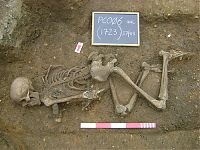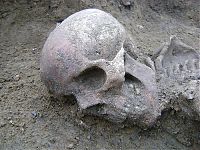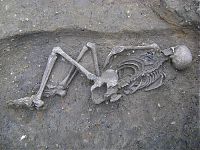Pondering the week ahead
- By: Ruth Rolfe |
- Sep 01, 2008
- Share
- del.icio.us

After a long Bank Holiday weekend, I got on the 06.41 into Liverpool Street and pondered what the week ahead would have in store. A cup of coffee, a cigarette, and I was down on site.
Previous reducing of levels on this part of the site had revealed several grave cuts, with the promise of skeletons to be found inside, and parts of skeletons protruding from the ground that needed their grave cuts to be found. However, you just can’t go in and excavate them all simultaneously, you have to work out their stratigraphic sequence. This meant that one of them tucked away in the corner had to wait its turn before it could be looked at. Well, today was its day and mine too! All I had to go on was a bit of knee cap that had been caught by the bucket of the big yellow trowel. You never know how much of a skeleton there will be left to excavate, or what the bone preservation will be like. Sometimes, thin bones, such as ribs seem to dissolve away to nothing leaving just the merest trace, so with no visible grave cut and just a bit of knee cap I hoped for the best. It soon became apparent that the knee cap had an attached femur, which in turn slotted nicely into a pelvis, that was associated with a column of vertebrae, with attendant rib-cage…….. you can see where I’m going with this…RESULT!! A complete articulated skeleton in perfect preservation. Context: 1723
What was really interesting about it was the position it was lying in. Resting on its right hip and right ribs, its right arm crossed its chest with the hand clenched in a fist sticking out from under the left set of ribs. The left hand was tucked under the left pelvis and the legs were flexed, the left lower than the right and the head was resting on the right. What a strange position to be buried in! It looks as if the poor thing had just decided to have a bit of a nap…..and forgot to wake up, or that she had been pushed into a pit and landed oddly.
Well you could imagine all sorts of weird scenarios for this one, but I think the explanation is, that the individual was laid to rest on her side, but later slumped over forwards to end up in the position we found her. This is not a unique occurance, as there are examples of skeletons having been found in this position on previous excavations of the Roman Cemetery. Oh, You may be wondering why I refer to the skeleton as ‘her’ well, its all down to the chin which was very rounded and narrow and a shallow pelvis ( which are only a two of many signs used to sex a skeleton so I could be totally wrong) but I felt I wanted to give her some sort of identity!
Cleaning the skeleton for photographs was very satisfying, I could have spend days getting every scrap of soil from them, however in commercial archaeology time is of the essence and so I prettied her up as best I could. Her bones have been lifted now and will be sent to an osteologist, who will determine her height, true sex and age ( and probably a lot of other stuff). The soil from beneath her stomach has also been sent for analysis which may tell us what she ate before she died. I hope that Strontium Isotope analysis will be done on her teeth too as that would tell us where she came from originally………there is so much information that can be gleaned from a skeleton and the context in which they were found, that’s what makes them so interesting, that why I love archaeology!
Little did I think when I pondered the week ahead it would have been so interesting, and yet there were more good things in store on Friday… but I’ll let my colleagues tell you all about that!


